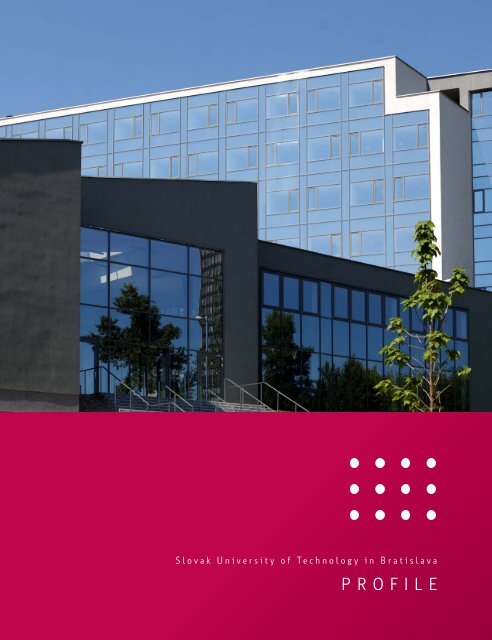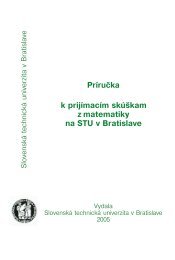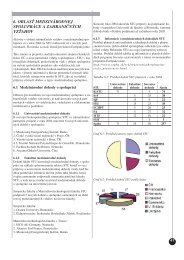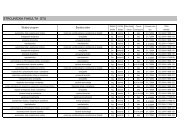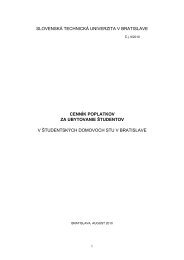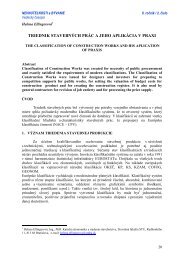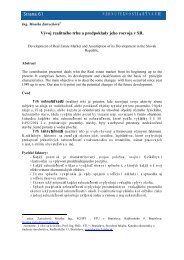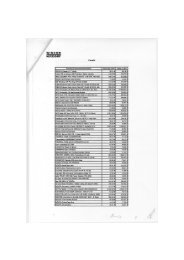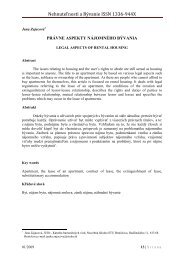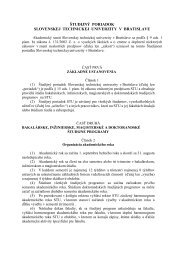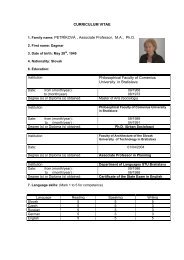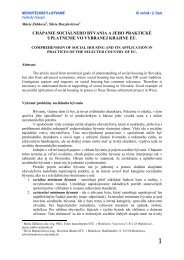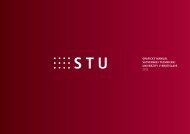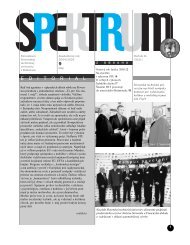PROFILE - Slovenská technická univerzita v Bratislave
PROFILE - Slovenská technická univerzita v Bratislave
PROFILE - Slovenská technická univerzita v Bratislave
Create successful ePaper yourself
Turn your PDF publications into a flip-book with our unique Google optimized e-Paper software.
Slovak University of Technology in Bratislava<br />
<strong>PROFILE</strong>
• • • • Slovak University of Technology in Bratislava<br />
Robert Redhammer<br />
Rector<br />
Slovak University of Technology in Bratislava<br />
2 •
Dear friends,<br />
For centuries, parents have strived to provide<br />
their children with the best education possible.<br />
For centuries, our teachers have made an effort<br />
to prepare their students for careers and lives<br />
as best they could. Parents choose the best<br />
schools, so that their children can study and<br />
live better than they did. They know that better<br />
education means a better life, and a better<br />
future.<br />
Availability of educational opportunities was<br />
one of the key reasons for founding the Slovak<br />
University of Technology in Bratislava (STU) 75<br />
years ago. The institution, known until 1991 as<br />
Slovenská vysoká škola technická, had a clear<br />
mission: To offer high-quality engineering<br />
education in Slovakia, so that Slovaks did not<br />
have to study abroad, and were not deprived of<br />
the chance for a better life.<br />
Today, STU is a modern university. With pride,<br />
it claims allegiance to the more than 200-yearold<br />
heritage of the modern Humboldt type<br />
of universities. Led by experienced academic<br />
staff, students are immersed in research and<br />
creative tasks. STU lets them experiment and<br />
helps them obtain needed skills. Students seek<br />
new knowledge, new technological solutions<br />
or artistic expression. All this rekindles the<br />
Leonardo da Vinci spirit: “Wisdom is the<br />
daughter of experience.”<br />
Moreover, STU’s character is connected with an even<br />
older heritage –the famous Mining Academy in Banská<br />
Štiavnica, known as Schemnitz. The academy, established<br />
250 years ago, has been continuously operating on the<br />
territory of today’s Slovakia for over 150 years. Its’concept<br />
of theoretical and practical education’ contributed many<br />
technical and technological innovations to the mining<br />
industry and generated progress in terms of higher<br />
education in engineering. The Schemnitz academy is, in<br />
fact, considered to be the first technical university of its<br />
kind worldwide. Both institutions, the Mining Academy as<br />
well as STU, offer a university level engineering education<br />
to a large number of students, based on scientific research<br />
linked directly with industry applications.<br />
Nowadays, the Slovak University of Technology in<br />
Bratislava is the flagship of university education in<br />
Slovakia. Recently published statistics demonstrate that<br />
graduates are among the most sought-after on the labor<br />
market, earning some of the highest salaries of graduates<br />
from any university in the country. In fact, graduates in the<br />
field of Information Technologies earn twice the average<br />
national income. What more could a teacher wish for?<br />
But we do want more. We have opened ourselves up to<br />
the world. We have signed contractual agreements with<br />
more than 400 institutions from around the globe. With<br />
regard to scientific production, we are among the top<br />
1,000 world institutions. Moreover, STU is listed among<br />
the prestigious Shanghai TOP 200 Academic Ranking of<br />
World Universities in computer sciences. We encourage<br />
our students and graduates to start their own businesses,<br />
thus creating jobs for others, and to use their results<br />
to help people live culturally and spiritually better and<br />
richer lives.<br />
Slovak University of Technology in Bratislava • • • •<br />
• 3
• • • • Slovak University of Technology in Bratislava<br />
STU’s Mission<br />
4 •
The Slovak University of Technology offers<br />
university education in engineering disciplines.<br />
Our education system is based on scientific<br />
research, as well as on artistic, engineering<br />
and other creative activities. Our faculties,<br />
departments, institutes and experts cooperate<br />
directly with industrial companies and<br />
social organisations, actively taking part in<br />
international cooperation.<br />
Vision<br />
Mission<br />
As a research-oriented technical university, STU’s mission is to<br />
achieve through scientific research, apply and disseminate new<br />
knowledge through engineering and other creative work, and<br />
educate and enlighten the young generation in the spirit of the<br />
principles of humanism and benevolence.<br />
Thus, STU develops harmony, knowledge, wisdom, goodness and<br />
creativity in a person and contributes to the development of<br />
education, science, culture and health for the good of society as<br />
a whole and, in so doing, contributes to the development<br />
of a knowledge-based society.<br />
Slovak University of Technology in Bratislava • • • •<br />
The Slovak University of Technology in<br />
Bratislava strives to be an internationally<br />
recognized and important, research-oriented<br />
technical university. It seeks to provide a<br />
high quality, internationally comparable<br />
education to a broad spectrum of students<br />
from the young generation in promising fields,<br />
based on independent and critical thinking,<br />
entrepreneurship and creativity, with a view<br />
to practical application and success in life,<br />
and taking into account the human aspects<br />
of education and technological progress. The<br />
university aims to contribute to the economic<br />
and social development of the region.<br />
Key figures *<br />
Number of students<br />
• 17,059<br />
• PhD. 1,536<br />
Number of graduates:<br />
• Bc. 2,192<br />
• Ing. 2,488<br />
• PhD. 247<br />
Nubmer of teaching staff<br />
• 3,058<br />
*<br />
figures 2012<br />
• 5
• • • • Slovak University of Technology in Bratislava<br />
Faculties and<br />
Institutes<br />
6 •
Faculties<br />
and Institutes<br />
Slovak University of Technology in Bratislava • • • •<br />
Faculty of Civil Engineering<br />
Faculty of Mechanical Engineering<br />
Faculty of Electrical Engineering and Information Technology<br />
Faculty of Chemical and Food Technology<br />
Faculty of Architecture<br />
Faculty of Materials Science and Technology<br />
Faculty of Informatics and Information Technologies<br />
Institute of Management<br />
• 7
• • • • Slovak University of Technology in Bratislava<br />
Faculty of Civil<br />
Engineering<br />
Faculty of Mechanical<br />
Engineering<br />
The Faculty of Civil Engineering is one of the largest<br />
faculties in Slovakia. It has over 30,000 Master-degree<br />
graduates, approximately 3,000 Bachelor-degree<br />
graduates, and over 1,000 PhD graduates.<br />
Many graduates of the Faculty of Mechanical<br />
Engineering reached top positions in international<br />
corporations, including Volkswagen, BMW,<br />
Mercedes, IBM or Siemens.<br />
Number of students: 3,935<br />
Number of teaching staff: 251<br />
Dean: Prof. Ing. Alojz Kopáčik, PhD.<br />
Number of students: 1,909<br />
Number of teaching staff: 126<br />
Dean: Prof. Ing. Ľubomír Šooš, PhD.<br />
Address:<br />
Radlinského 11, 813 68 Bratislava<br />
www.svf.stuba.sk<br />
Address:<br />
Námestie slobody 17, 812 31 Bratislava<br />
www.sjf.stuba.sk<br />
Areas of activities:<br />
building constructions, building environment<br />
technology, construction technologies, environment<br />
protection constructions, geodesy and cartography,<br />
land constructions, transportation constructions,<br />
mathematical-computational modelling, water<br />
constructions and water systems<br />
Areas of activities:<br />
applied mechanics, automation, chemical and food<br />
machines and devices, engineering technologies and<br />
materials, environmental technology, fluid, thermal,<br />
hydraulic and production machinery, mechatronics,<br />
meteorology, production quality systems, traffic<br />
engineering<br />
8 •
Slovak University of Technology in Bratislava • • • •<br />
Faculty of Electrical<br />
Engineering and Information<br />
Technology<br />
Faculty provides well-balanced mixture of theory and<br />
practical experience. Employment rate of faculty’s<br />
graduates reaches almost 100 %, with their starting<br />
salaries being among the highest in the economy.<br />
Number of students: 2,751<br />
Number of teaching staff: 229<br />
Dean: Prof. RNDr. Gabriel Juhás, PhD.<br />
Address:<br />
Ilkovičova 3, 812 19 Bratislava<br />
www.fei.stuba.sk<br />
Areas of activities:<br />
automation and management, electrical and heavycurrent<br />
power engineering, electronics, engineering<br />
for power materials, informatics, photonics, physics,<br />
telecommunications<br />
Faculty of Chemical<br />
and Food Technology<br />
For an extended period of time, the faculty has been on<br />
the top of Slovakia’s list of highest-quality technical<br />
faculties. As the only school in Slovakia, it prepares<br />
experts for the entire spectrum of the chemical, food,<br />
pharmaceutical and cosmetics industry, as well as for<br />
various other environmental, biotechnological and<br />
research and development fields.<br />
Number of students: 2,268<br />
Number of teaching staff: 181<br />
Dean: Prof. Ing. Ján Šajbidor, DrSc.<br />
Address:<br />
Radlinského 9, 812 37 Bratislava<br />
www.fchpt.stuba.sk<br />
Areas of activities:<br />
biotechnologies, chemical engineering, environmental<br />
engineering, food chemistry and technologies, fuels and<br />
polymers, inorganic and organic technologies, inorganic,<br />
organic, analytical and physical chemistry<br />
• 9
• • • • Slovak University of Technology in Bratislava<br />
Faculty of Architecture<br />
The Faculty of Architecture is the largest and oldest<br />
architecture school in Slovakia, educating experts<br />
capable of designing and engineering works in areas of<br />
architecture, urban development, design, landscape and<br />
garden architecture.<br />
Number of students: 1,320<br />
Number of teaching staff: 114<br />
Dean: doc. Ing. arch. Ľubica Vitková, PhD.<br />
Address:<br />
Námestie slobody 19, 812 45 Bratislava<br />
www.fa.stuba.sk<br />
Areas of activities:<br />
architecture and urban development, landscape and<br />
garden architecture, product design<br />
Faculty of Materials Science<br />
and Technology<br />
Thanks to its combination of study programmes, the<br />
Faculty of Materials Science and Technology is the only<br />
one of its kind in Slovakia. Education is based on the most<br />
recent scientific and research discoveries integrated in<br />
departments of excellence.<br />
Number of students: 3,418<br />
Number of teaching staff: 206<br />
Dean: Prof. Dr. Ing. Oliver Moravčík<br />
Address:<br />
Paulínska 16, 917 24 Trnava<br />
www.mtf.stuba.sk<br />
Areas of activities:<br />
applied informatics and automation, industrial<br />
management, material engineering, processing and<br />
application of non-metals, production machinery and<br />
systems, production technologies<br />
10 •
Slovak University of Technology in Bratislava • • • •<br />
Faculty of Informatics<br />
and Information Technologies<br />
As the only school in Slovakia, the faculty focuses<br />
exclusively on the field of Information Technologies.<br />
Demand for its graduates is high, with their starting<br />
salaries being among the highest ones in the economy.<br />
Number of students: 1,198<br />
Number of teaching staff: 55<br />
Dean: doc. Ing. Pavel Čičák, PhD.<br />
Address:<br />
Ilkovičova 3, 842 16 Bratislava<br />
www.fiit.stuba.sk<br />
Areas of activities:<br />
computer engineering, data mining, informatics,<br />
information systems, security, software engineering, web<br />
onthology<br />
Institute of Management<br />
Institute of Management is an autonomous unit<br />
providing research and pedagogic activities in the<br />
area of management and urban planning, closely<br />
cooperating with other university units, domestic and<br />
foreign universities and other scientific and academic<br />
institutions.<br />
Number of students: 260<br />
Number of teaching staff: 35<br />
Director: doc. Ing. Marián Zajko, PhD., MBA<br />
Address:<br />
Vazovova 5, 812 43 Bratislava<br />
www.stuba.sk<br />
Areas of activities:<br />
business management, entrepreneurship education,<br />
industrial economy, urban planning<br />
• 11
• • • • Slovak University of Technology in Bratislava<br />
Human Resources<br />
Management of STU<br />
Rector: Prof. Ing. Robert Redhammer, PhD.<br />
Vice-rector for development: Prof. Ing. Milan Sokol, PhD.<br />
Vice-rector for cooperation: Prof. Ing. Marián Peciar, PhD.<br />
Vice-rector for education: doc. Ing. František Horňák, PhD.<br />
Vice-rector for science: Prof. Ing. Stanislav Biskupič, DrSc.<br />
Bursar: Ing. Dušan Faktor, PhD.<br />
We are one of the largest employers in the city of Bratislava<br />
Highly qualified staff<br />
professors<br />
186<br />
associate professors<br />
348<br />
PhD assistants<br />
765<br />
assistants<br />
674<br />
qualification structure of teaching staff<br />
Professor<br />
gives lectures and oversees study programs, determining academic direction<br />
Associate professor<br />
gives lectures, participates in overseeing study programs and individual subjects<br />
PhD assistant<br />
leads seminars, exercise and labs<br />
assistant without PhD<br />
works on seminars, exercises and labs<br />
12 •
Research<br />
Research plays a key role in the education<br />
process. Thanks to research, we are able to<br />
prepare well educated and highly trained<br />
experts. Our graduates work with the most<br />
up-to-date knowledge and receive hands-on<br />
experience with the most recent technologies,<br />
discovering new knowledge and technical<br />
solutions. STU is one of the only five Slovak<br />
organisations to have received the SCIMAGO<br />
institutional ranking for contribution to the<br />
world science.<br />
Research AREAS<br />
Slovak University of Technology in Bratislava • • • •<br />
Financing Research<br />
Activities<br />
Research activities are financed almost<br />
exclusively from external and third-party<br />
sources, namely the Slovak and foreign grants,<br />
industry cooperation agreements and European<br />
structural funds. In 2012, the third-party<br />
resources reached 1/3 of the whole budget.<br />
University has a stable position in this area<br />
among the public universities. We manage to<br />
secure approximately 25% of the total amount<br />
of finances set aside for all schools for national<br />
grant agencies, or 35% of finances obtained<br />
from abroad by all 20 public higher education<br />
institutions in the country.<br />
20 % Construction<br />
7 % Materials and Technologies<br />
3 % Architecture<br />
35 % Chemical and Food Processing Technologies<br />
27 % Electrical Engineering and Information Technologies<br />
9 % Mechanical Engineering<br />
World-class Experience<br />
Outstanding success was achieved namely in the filed of Discrete<br />
Mathematics. The team led by professor Radko Mesiar of the<br />
Department of Mathematics and Descriptive Geometry has produced<br />
as much as 7 % of the total world’s scientific production in their<br />
field of expertise. The SciVal Spotlight analysis, based on cocitation<br />
analysis of published original scientific papers in renowned<br />
international journals, has recognised 42 world-class competences<br />
for STU.<br />
• 13
• • • • Slovak University of Technology in Bratislava<br />
Centres of excellence<br />
Six specialised research centres have been<br />
recently selected as excellent:<br />
Centre of Excellence of Integrated<br />
Flood Protection Systems<br />
Top research FP7 projects<br />
MAS – Nanoelectronics for Mobile Ambient Living (AAL) Systems<br />
(2010 – 2013)<br />
MORGAN – Materials for Robust Gallium Nitride<br />
(2008 – 2011)<br />
IDESA-2 – Implementation of widespread IC design skills in advanced<br />
deep submicron Technologies at European Academia<br />
(2010 – 2012)<br />
TRASNUSAFE – Training schemes on nuclear safety culture<br />
(2010 – 2014)<br />
ENEN-RU – Cooperation with Russia in Nuclear Education,<br />
Training and Knowledge Management<br />
(2011 – 2013)<br />
The department for Water Supply Management<br />
at STU have continuously worked on developing<br />
integrated flood protection systems with the<br />
support of eco systems in a catchment area.<br />
This integrated approach is supported by<br />
research in mathematics, geo-informatics and<br />
construction geodesy. Some of the research<br />
projects are being delivered under the UNESCO<br />
international hydrology programme.<br />
Contact:<br />
Prof. Ing. Peter Dušička, PhD.<br />
e-mail: peter.dusicka@stuba.sk<br />
phone: +421 903 240 761<br />
www.ceipo.svf.stuba.sk<br />
14 •<br />
HBB Next – Next Generation Hybrid Broadcast Broadband<br />
(2011 – 2013)<br />
SMAC – SMArt systems and Co – design (2011 – 2014)<br />
KBBE – Biocatalysis of new generation<br />
for industrial chemical synthesis<br />
(2011– 2014)<br />
DIVERSITY – Improving the gender diversity management<br />
in materials research institutions<br />
(2009 – 2011)<br />
FU07 – Chemical sputtering: Computational modelling of<br />
interactions in the carbon-containing films exposed<br />
to molecular ions and hydrogen. EUROATOM CU<br />
(2010 –2011)<br />
MANUNET Met-Spin – Multivariate optimization of the metal<br />
spinning processes-research and development<br />
(2009 – 2011)<br />
CIP MyUniversity – Decision making for a united higher education<br />
(2010 – 2013)<br />
Centre of the Development<br />
and Application of Advanced<br />
Diagnostic Methods in the<br />
Processing of Metallic and<br />
Non-metallic Materials<br />
Research is oriented on “physical metallurgy“.<br />
It includes the changing of a structure and<br />
properties of coatings on selected metal materials<br />
through modifications in the chemical and<br />
phase composition of thin and hard layers and<br />
their combinations. Strong cooperation partner<br />
is Forschungszentrum Dresden-Rossendorf in<br />
Germany dedicated to Cluster Structures and<br />
Nano Materials.<br />
Contact:<br />
Assoc. Prof. Ľubomír Čaplovič, PhD.<br />
e-mail: lubomir.caplovic@stuba.sk<br />
phone: +421 918 646 043
Centre of Excellence for the<br />
Settlement Infrastructure<br />
Development of the Knowledge<br />
Based Economy - SPECTRA+<br />
SPECTRA+ is a co-ordination core of the Centre<br />
for Urban Infrastructure – infrastructure<br />
planning and development in relation to globalisation,<br />
rise of the knowledge economy along<br />
with increasing environmental concerns. For<br />
its significant contribution under Framework<br />
Programme 5, SPECTRA+ was awarded a status<br />
of the “Central European Research and Training<br />
Centre in Spatial Planning“ by the European<br />
Commission in Brussels.<br />
Centre of Exellence of Five Axis Machining<br />
This area focuses on the introduction of the new 5 axis machining<br />
solutions previously not considered in Slovakia. Prior to that,<br />
researchers gained experience working on projects with 3 and 4 axis<br />
machining together with the STU’s School of Materials Science &<br />
Technology in Trnava and Forschungszentrum Dresden Rossendorf, a<br />
high-profile research institute in Dresden, Germany.<br />
Contact:<br />
Prof. Dr. Ing. Jozef Peterka<br />
e-mail: jozef.peterka@stuba.sk<br />
phone: +421 905 930 245<br />
www.mtf.stuba.sk/english/events-news/news/centre-of-<br />
-excellence-5-axis-machining.html?page_id=5589<br />
Slovak University of Technology in Bratislava • • • •<br />
Contact:<br />
prof. Ing. arch. Maroš Finka, PhD.<br />
e-mail: maros.finka@stuba.sk<br />
phone: +421 905 612 465<br />
www.spectra-perseus.sk/Projects/SPECTRA<br />
National Centre for Research and<br />
Application of Renewable Energy<br />
Sources<br />
Centre of Excellence for SMART Technologies,<br />
Systems and Services<br />
Experts in this area actively co-operate with all key national and international<br />
organisations. Among others, they achieved good results<br />
in many fields, e. g. micro- and nanoelectronics, sensors, photonics<br />
(in femtosecond scale), software development, information systems,<br />
artificial intelligence, automation, cybernetics, telecommunications<br />
and computer science.<br />
Experts engage in basic and applied research<br />
in using biomass, organic polymeric materials,<br />
solar and hydro energy for heat and power and<br />
production of new materials. This includes<br />
anaerobic digestion of organic waste, products<br />
derived from the pyrolysis of used tyres, hybrid<br />
systems with membranes and solvents based<br />
on ionic liquids, kinetic study of radical reactions<br />
through methods of electron paramagnetic<br />
resonance and thermal analysis and many others.<br />
Contact:<br />
Prof. Ing. František Janíček, PhD.<br />
e-mail: frantisek.janicek@stuba.sk<br />
phone: +421 (2) 60 291 298<br />
www.nc-oze.stuba.sk<br />
Contact:<br />
Prof. Ing. Daniel Donoval, PhD.<br />
e-mail: daniel.donoval@stuba.sk<br />
phone: +421 (2) 60 291 372, +421 (2) 60 291 358<br />
+421 (2) 65 423 486<br />
STU Research Centre<br />
Vazovova 5, 812 43 Bratislava, Slovakia<br />
www.stuba.sk/research<br />
• 15
• • • • Slovak University of Technology in Bratislava<br />
Cooperation<br />
with industry<br />
16 •
For a university of technology, intense<br />
cooperation with the private sector is<br />
inevitable. By discovering unique solutions<br />
to contemporary technical issues, university<br />
enriches its research activities, accelerates<br />
transfer of knowledge, while gaining financial<br />
support for its development.<br />
Cooperation with industry has various forms.<br />
These include tasks performed on the basis of a<br />
direct agreement or an order, but also research<br />
and innovation projects executed in cooperation<br />
with partners from industries, involvement of<br />
SMEs in solving international projects,student<br />
internships in businesses, or even support<br />
for founding small companies with ties to<br />
university environment.<br />
Examples of Cooperation<br />
With total revenues exceeding € 7 million, the<br />
Competence Centre of Intelligent Technologies<br />
For Computerisation and Informatisation of<br />
Systems and Services (INTELINSYS) is one of<br />
the best examples of STU’s cooperation with<br />
real businesses. Along with the Comenius<br />
University, the International Laser Centre<br />
and the Institute of Informatics of the Slovak<br />
Academy of Sciences (IISAV), members of this<br />
consortium also include industrial producers<br />
such as Siemens, APPLIED PRECISION,<br />
NanoDesign, Prvá zváračská, MicroStep – MIS<br />
and Centire Research.<br />
Our STRATEGIC Partners<br />
Volkswagen Slovensko<br />
PSA Peugeot Citroën Slovakia<br />
Siemens<br />
Slovenské elektrárne<br />
Slovenský plynárenský priemysel<br />
Hewlett-Packard Slovakia<br />
Alcatel-Thales<br />
MicroStep group<br />
PPA Controll<br />
VÚJE<br />
IBM<br />
Accenture<br />
BEL/NOVAMANN<br />
ISTRAN<br />
Applied Precision<br />
Saint-Gobain Construction Products, division Weber-Terranova<br />
Baumit<br />
Premac<br />
Wienerberger – Slovenské tehelne<br />
VKÚ<br />
Johnson Controls International<br />
Durisol-Stav<br />
Holcim Slovensko<br />
and many others<br />
Slovak University of Technology in Bratislava • • • •<br />
• 17
• • • • Slovak University of Technology in Bratislava<br />
Know-How Centre<br />
The primary mission of the centre is protecting intellectual property, and creating<br />
positive environment for technology transfer.<br />
Know-How Centre is the contact point for commercial and industry companies<br />
interested in STU’s consulting and expertise, utilising its labs, equipments, contractual<br />
research, or leasing licensed technology.<br />
STU improves its tech-transfer services in direct cooperation with world leading ISIS<br />
Enterprise Ltd. – University of Oxford Centre for technology transfer.<br />
18 •
Slovak University of Technology in Bratislava • • • •<br />
University Technology<br />
Business Incubator<br />
As one of few Central European universities,<br />
STU has its own technology business incubator<br />
focused on supporting small technological<br />
enterprises. It was established thanks to the<br />
support from the PHARE fund. Since 2005,<br />
the incubator has been renting premises at<br />
advantageous rates to innovative start-up<br />
companies. In addition, it offers a range of<br />
support and consulting services. So far, the<br />
incubator has supported 35 start-up companies<br />
and hundreds of individuals.<br />
Icnubator offers following two programmes:<br />
The Start-up Office programme is designed for students and<br />
graduates, who plan to establish their own innovative business with<br />
focus on offering products and services in the area of technology.<br />
For 3 months, they can use an equipped office, as well as consulting<br />
in the area of setting up a business and drafting a business plan.<br />
The InQb Programme is designed for those who are either<br />
planning to, or have already established their own innovative<br />
business focused on offering products and services in the area of<br />
technology. During a period of 3 years, the incubated companies can<br />
use a wide range of benefits, including technical support, consulting<br />
and marketing services.<br />
• 19
• • • • Slovak University of Technology in Bratislava<br />
International<br />
Mobility<br />
20 •
We keep long-term relations with foreign universities<br />
and institutions, and systematically<br />
reach new cooperation agreements. This way,<br />
we create conditions for cooperation between<br />
faculties, departments and individuals.<br />
Contractual partnerships enable us to participate<br />
in international projects, which are among<br />
our university’s key activities. Not only do they<br />
produce financial sources for us, but they also<br />
contribute to further development of the university,<br />
providing for mobility of the teachers,<br />
as well as postgraduate and regular students.<br />
As of today, we have singed 411 agreements on<br />
international cooperation with 203 institutions<br />
from 45 countries from around the world.<br />
Mobility Programmes<br />
In the area of education, in 2012 we financed most of our projects<br />
from the CEEPUS programme. The programme supports exchange<br />
study stays of students and teachers in central European countries.<br />
We have also participated in European Union’s extensive project<br />
entitled Lifelong Learning Programme; its goal is to support<br />
education and professional preparation. We have executed projects<br />
within the Leonardo da Vinci programmes (specialised education),<br />
Mobility (mobility of students, teachers and workers), Multilateral<br />
Programmes (innovative cooperation of universities with partners<br />
active outside of the education sector), Intensive Programmes<br />
(teaching special topics designed for multi-national groups) and<br />
Academic and Structural Networks (innovations in specific academic<br />
fields).<br />
Slovak University of Technology in Bratislava • • • •<br />
Academic Mobility<br />
Within the mobility programmes, we send our<br />
students to foreign studies or professional<br />
internships in companies abroad, which usually<br />
last from three to twelve months. They are executed<br />
within various projects of international<br />
Programmes. Since 1988, when we started<br />
participating in this programme, 1,229 students<br />
travelled abroad for studies and internships of<br />
all levels. Already for several years, our students<br />
have been taking scholarships at the Kanazawa<br />
University in Japan. Also, students take work<br />
internships in Japanese companies within the<br />
Vulcanus international programme.<br />
Overview of International Projects<br />
21 CEEPUS<br />
17 7. framework programme<br />
4 6. framework programme<br />
10 LLP<br />
7 Bilateral cooperation<br />
3 DAAD<br />
3 International cooperation<br />
2 Tempus 2<br />
2 Erasmus Mundus 2<br />
46 Other<br />
• 21
• • • • Slovak University of Technology in Bratislava<br />
NETWORKING<br />
The university, its faculties and employees are active in<br />
important European and international professional, educational,<br />
scientific and artistic organisations.<br />
The international bilateral and multilateral framework<br />
agreements create conditions for cooperation between faculties,<br />
departments, institutes and individuals. Partnerships within the<br />
Lifelong Learning Programme and its Erasmus subdivision also<br />
play an important role.<br />
As of today, STU cooperates with 411 partnership universities<br />
from around the world.<br />
22 •
Slovak University of Technology in Bratislava<br />
European Associaton of Universities<br />
European Society for Engineering Education<br />
Faculty of Civil Engineering<br />
Federation of European Heating<br />
and Air Conditioning Associations<br />
Association of European Civil Engineering Faculties<br />
Faculty of Mechanical Engineering<br />
Federation of European Materials Societies<br />
American Society of Mechanical Engineers<br />
Faculty of Electrical Engineering and Information<br />
Technology<br />
European Physical Society<br />
International Quantum Structures Association<br />
Faculty of Architecture<br />
Fédération Internationale d’lnstitut d’Études<br />
Médiévales<br />
Faculty of Materials Science and Technology in Trnava<br />
Internationale Gesellschaft fur Ingenierpädagogik<br />
European Alliance of Innovation<br />
European Platform of Women Scientists<br />
European Network Education and Training in<br />
Occupational Safety & Health<br />
Institute of Management<br />
Network of Spatial Research and Planning Institutes in<br />
Central and Eastern Europe<br />
Akademie fur Raumforschung und Landesplanung<br />
Our most important partners<br />
University of Technology, Australia<br />
Technische Universität Wien, Austria<br />
Stadt Wiener Neustadt-Landesregierung, Austria<br />
Université du Quebec á Rimouski, Canada<br />
University of Alberta, Canada<br />
České vysoké učení technické, Czech Republic<br />
Universidad de Chile, Chile<br />
Tianjin University, China<br />
Universidad Nacional de Colombia, Columbia<br />
Universidad Central Marta Abreu de Las Villas, Cuba<br />
Association for Education and Cultural Services of Cairo, Egypt<br />
Ecole Nationale Superieure de Chimie de Rennes, France<br />
L’Université Pierre et Marie Curie, France<br />
Bauhaus-Universität Weimar, Germany<br />
Leibniz Institut für Festkörper und Werkstofforschung Dresden, Germany<br />
Martin Luther Universität Halle-Wittenberg, Germany<br />
Technische Universität München, Germany<br />
National and Kapodistrian University of Athens, Greece<br />
Budapesti Müszaki és Gazdaságtudományi Egyetem, Hungary<br />
University of Akureyri, Island<br />
Fondazione Romualdo Del Bianco, Italy<br />
Musashi Institute of Technology, Japan<br />
Karaganda State Technical University, Kazakhstan<br />
Kyrgyz State Technical University I. Razzakova, Kyrgyz Republic<br />
Vilnius Gediminas Technical University, Lithuania<br />
Universidad Politécnica de Pachuca, Mexico<br />
Technische Universiteit Eindhoven, Netherlands<br />
Akademija Górniczo-Hutnicza imeni Stanislawa Staszica, Poland<br />
Politechnika Warszawska, Poland<br />
Politechnika Krakowska imeni Tadeusza Kosciuszki, Poland<br />
Sankt-Peterburskyj Gosudarstvennyj Universitet, Russia<br />
Omskij Gosudarstvennyj Universitet Putej Soobščenija, Russia<br />
Moskovskij Gosudarstvennyj Institut Stali i Splavov, Russia<br />
Ufa Scientific Centre of Russian Academy of Science, Russia<br />
Voronezh State Technological Academy, Russia<br />
University of Belgrade, Serbia<br />
Pohang University of Science and Technology, South Korea<br />
Universidad Politecnica de Valencia, Spain<br />
KTH Kungliga Tekniska Högskolan, Sweden<br />
National Taiwan University of Science and Technology, Taiwan<br />
Kyiv Politechnic Institute Ukraine, Ukraine<br />
Michigan State University in East Lansing, USA<br />
University of Virginia, USA<br />
Robert Morris University, USA<br />
Hanoi University of Technology, Vietnam<br />
Slovak University of Technology in Bratislava • • • •<br />
• 23
• • • • Slovak University of Technology in Bratislava<br />
Services<br />
for students<br />
24 •
Slovak University of Technology in Bratislava • • • •<br />
University offers extensive social support and<br />
services to our students, including three types<br />
of scholarships. Social scholarship is provided<br />
for socially disadvantaged groups to cover their<br />
living expenses; motivation scholarships are<br />
awarded to 10% of the most successful students<br />
for results achieved in the previous academic<br />
year; and special scholarships are provided for<br />
excellent achievements in research, artistic<br />
activities and sports, as well as for outstanding<br />
study results during the entire course of<br />
studies.<br />
Student life<br />
Students use many facilities for studying as well as spending their<br />
free time.<br />
• Well-equipped libraries and study rooms featuring<br />
over 400,000 library units,<br />
• online access to international databases,<br />
• modern approach to education (e-learning, distance studies, etc.),<br />
• special workshops and labs,<br />
• PC labs,<br />
• free Internet access.<br />
Student Housing<br />
• 7 dormitories with a capacity for 5,900 students,<br />
• accommodation located within 10 minutes (on foot or by public<br />
transportation) from school facilities,<br />
• one-, two- and three-bed rooms with standard facilities<br />
(individual or shared showers), Internet access, shared kitchens,<br />
• canteens and buffets in student dorms and faculty premises,<br />
• basic medical care in student dorms.<br />
• 25
• • • • Slovak University of Technology in Bratislava<br />
Free Time & Leisure<br />
Activities<br />
Since its establishment in 1953, the<br />
university’s artistic ensemble Technik not<br />
only provides students an opportunity to take<br />
part in cultural activities, but also represents<br />
the university nationally and abroad. It has<br />
three divisions – a folk ensemble, a choir and<br />
a chamber orchestra.<br />
University offers many sport centres,<br />
playgrounds, gymnasium and two swimming<br />
pools. They serve for teaching process as<br />
well as for training of university top sport<br />
teams, Slávia STU and student free time<br />
activities. Students can choose from a range<br />
of sports such as volleyball, basketball, tennis,<br />
swimming, skiing, horseback riding, karate,<br />
yoga, athletics, etc.<br />
26 •
Other Interests<br />
Slovak University of Technology in Bratislava • • • •<br />
Ynet is a students’ organisation established in December<br />
2000 in a response to the students’ growing interest in<br />
networking technologies. During its existence, it has built<br />
top-class ‘active ethernet’ networks with Internet access<br />
at three student dorms, with the fourth being currently<br />
modernised.<br />
IRŠ TLIS is an abbreviation standing for One-Thousand-<br />
Bed Dormitory Building’s Radio Station, meaning the<br />
Mladosť student dorm. It was established over 30 years<br />
ago, spawning for example the now-defunct Ragtime<br />
radio. The station broadcasts at the Mladosť dorm<br />
building, or online on www.tlis.sk.<br />
Chemnet is a civic association, which has been operating<br />
the academic network on the Mladá garda student dorm<br />
since 2003. It is designed for student purposes, namely<br />
studies and covering other interests in the area of IT, as<br />
well as searching for valuable scientific information.<br />
Omega is a radio-club of STU students. The history of<br />
their collective radio station OM3KFF reaches back to<br />
1953. Along with short-wavelength contests, today the<br />
club increasingly focuses also on ultra-short wavelength<br />
and microwave band contests.<br />
mc2 is a student on-line TV. It has been broadcasting from<br />
studios based at the Mladosť student dorms in Mlynská<br />
Dolina since February 2009. Its programme is prepared<br />
and created by a team of some 35 university, not only STU<br />
students, offering their own take on TV broadcasting.<br />
• 27
Slovenská technická <strong>univerzita</strong> v <strong>Bratislave</strong><br />
Vazovova 5, 812 43 Bratislava 1<br />
e-mail: public@stuba.sk<br />
www.stuba.sk


